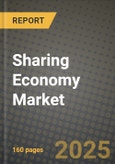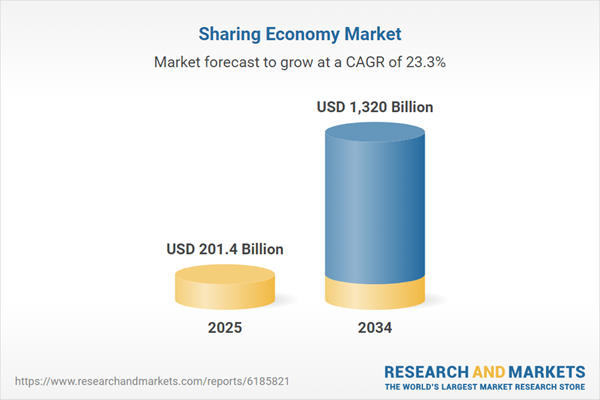The sharing economy market has emerged as a transformative force, redefining consumption by promoting access over ownership. It encompasses a wide array of peer-to-peer services and platforms that facilitate the sharing of goods, services, or spaces - ranging from ride-hailing and home-sharing to freelance work, equipment rentals, and co-working spaces. Driven by advancements in mobile technology, digital payment systems, and real-time communication, the sharing economy offers convenience, cost savings, and enhanced asset utilization. Consumers are increasingly drawn to the flexibility and personalization these services offer, while businesses leverage sharing models to reduce overhead and increase scalability. The market is gaining traction across the globe, particularly among millennials and Gen Z, who prioritize sustainability, minimalism, and collaborative consumption. As more industries adopt asset-light business models, the sharing economy is evolving into a core pillar of modern, decentralized commerce.
The sharing economy market experienced robust growth across both developed and emerging regions. Leading platforms diversified their service offerings - Airbnb expanded into curated local experiences, while Uber added package delivery and fleet leasing for gig workers. A growing number of startups introduced sector-specific sharing platforms, such as peer-to-peer fashion rentals and tool-sharing services. The integration of AI and blockchain began improving trust, transparency, and operational efficiency, with decentralized platforms offering smart contracts and identity verification. Governments in key markets initiated regulatory frameworks to ensure fair competition, tax compliance, and user safety. Meanwhile, businesses and consumers showed a stronger preference for environmentally conscious sharing models, encouraging circular consumption. Freelance and gig work platforms expanded their value propositions by offering healthcare, insurance, and financial services to retain workers. In essence, 2024 marked a shift toward professionalization, platform accountability, and increased user sophistication in the sharing economy landscape.
The sharing economy market is expected to become more integrated, localized, and sustainable. Urban planning will increasingly incorporate shared mobility, co-living, and co-working infrastructure, supporting dense, tech-enabled communities. As AI-powered personalization advances, platforms will offer hyper-localized services tailored to individual needs and schedules. Environmental regulations and consumer demand will drive the growth of green sharing models, with electric vehicles, reusable goods, and zero-waste practices becoming more central to platform strategies. Cross-industry collaborations - such as real estate developers partnering with home-sharing firms or automakers with car-sharing startups - will broaden market scope and streamline operations. At the same time, emerging markets will see accelerated growth due to rising smartphone penetration and a growing middle class. Governments may expand regulatory oversight, focusing on data protection, labor rights, and taxation. The future of the sharing economy lies in its ability to balance innovation with inclusivity, ethics, and long-term sustainability.
Key Insights: Sharing Economy Market
- Decentralized platforms using blockchain are increasing transparency, user trust, and autonomy by enabling smart contracts, secure transactions, and verified digital identities.
- Green sharing models, including electric car-sharing, clothing rentals, and circular product reuse, are gaining popularity among environmentally conscious consumers.
- Integration of gig platforms with financial and healthcare services is helping attract and retain freelancers, offering added security in a flexible work model.
- Hyperlocal service delivery is rising, with platforms focusing on neighborhood-level logistics, skill-sharing, and short-distance rentals to enhance user convenience.
- Collaborative business models involving partnerships between traditional enterprises and sharing platforms are expanding service offerings and operational reach.
- Consumer preference for access over ownership is driving demand for flexible, on-demand services that reduce upfront costs and long-term commitments.
- Rapid smartphone adoption and digital connectivity enable seamless booking, tracking, and payments, making sharing platforms more accessible and user-friendly.
- Economic uncertainties and the rising cost of living are pushing individuals to monetize idle assets or freelance skills through sharing platforms.
- Growing environmental awareness is encouraging users to participate in sustainable consumption practices offered through circular and collaborative economies.
- Regulatory uncertainty remains a challenge as governments struggle to classify, tax, and monitor peer-to-peer services, leading to compliance issues and operational risks for platform providers.
Sharing Economy Market Segmentation
By Product
- Shared Transportation
- Shared Space
- Sharing Financial
- Sharing Food
- Shared Health Care
- Shared Knowledge Education
- Shared Task Service
- Shared Items
- Other Products
By Distribution Channel
- Online
- Offline
By End User
- Generation Z
- Millennials
- Generation X
- Boomers
Key Companies Analysed
- Uber Technologies Inc
- Didi Global
- JLL
- Booking Holdings Inc
- Avis Budget Group
- eBay Inc
- Airbnb Inc
- Snap
- Accor SA
- Lyft Inc
- Lime
- Fiverr International Ltd
- Prosper
- BlaBlaCar
- Zipcar
- Fon
- JustPark
- Spotahome
- Couchsurfing
- Eatwith
- HubbleHQ
- E-stronger
- VaShare
- Stashbee Limited
- Steam
Sharing Economy Market Analytics
The report employs rigorous tools, including Porter’s Five Forces, value chain mapping, and scenario-based modeling, to assess supply-demand dynamics. Cross-sector influences from parent, derived, and substitute markets are evaluated to identify risks and opportunities. Trade and pricing analytics provide an up-to-date view of international flows, including leading exporters, importers, and regional price trends.Macroeconomic indicators, policy frameworks such as carbon pricing and energy security strategies, and evolving consumer behavior are considered in forecasting scenarios. Recent deal flows, partnerships, and technology innovations are incorporated to assess their impact on future market performance.
Sharing Economy Market Competitive Intelligence
The competitive landscape is mapped through proprietary frameworks, profiling leading companies with details on business models, product portfolios, financial performance, and strategic initiatives. Key developments such as mergers & acquisitions, technology collaborations, investment inflows, and regional expansions are analyzed for their competitive impact. The report also identifies emerging players and innovative startups contributing to market disruption.Regional insights highlight the most promising investment destinations, regulatory landscapes, and evolving partnerships across energy and industrial corridors.
Countries Covered
- North America - Sharing Economy market data and outlook to 2034
- United States
- Canada
- Mexico
- Europe - Sharing Economy market data and outlook to 2034
- Germany
- United Kingdom
- France
- Italy
- Spain
- BeNeLux
- Russia
- Sweden
- Asia-Pacific - Sharing Economy market data and outlook to 2034
- China
- Japan
- India
- South Korea
- Australia
- Indonesia
- Malaysia
- Vietnam
- Middle East and Africa - Sharing Economy market data and outlook to 2034
- Saudi Arabia
- South Africa
- Iran
- UAE
- Egypt
- South and Central America - Sharing Economy market data and outlook to 2034
- Brazil
- Argentina
- Chile
- Peru
Research Methodology
This study combines primary inputs from industry experts across the Sharing Economy value chain with secondary data from associations, government publications, trade databases, and company disclosures. Proprietary modeling techniques, including data triangulation, statistical correlation, and scenario planning, are applied to deliver reliable market sizing and forecasting.Key Questions Addressed
- What is the current and forecast market size of the Sharing Economy industry at global, regional, and country levels?
- Which types, applications, and technologies present the highest growth potential?
- How are supply chains adapting to geopolitical and economic shocks?
- What role do policy frameworks, trade flows, and sustainability targets play in shaping demand?
- Who are the leading players, and how are their strategies evolving in the face of global uncertainty?
- Which regional “hotspots” and customer segments will outpace the market, and what go-to-market and partnership models best support entry and expansion?
- Where are the most investable opportunities - across technology roadmaps, sustainability-linked innovation, and M&A - and what is the best segment to invest over the next 3-5 years?
Your Key Takeaways from the Sharing Economy Market Report
- Global Sharing Economy market size and growth projections (CAGR), 2024-2034
- Impact of Russia-Ukraine, Israel-Palestine, and Hamas conflicts on Sharing Economy trade, costs, and supply chains
- Sharing Economy market size, share, and outlook across 5 regions and 27 countries, 2023-2034
- Sharing Economy market size, CAGR, and market share of key products, applications, and end-user verticals, 2023-2034
- Short- and long-term Sharing Economy market trends, drivers, restraints, and opportunities
- Porter’s Five Forces analysis, technological developments, and Sharing Economy supply chain analysis
- Sharing Economy trade analysis, Sharing Economy market price analysis, and Sharing Economy supply/demand dynamics
- Profiles of 5 leading companies - overview, key strategies, financials, and products
- Latest Sharing Economy market news and developments
Additional Support
With the purchase of this report, you will receive:- An updated PDF report and an MS Excel data workbook containing all market tables and figures for easy analysis.
- 7-day post-sale analyst support for clarifications and in-scope supplementary data, ensuring the deliverable aligns precisely with your requirements.
- Complimentary report update to incorporate the latest available data and the impact of recent market developments.
This product will be delivered within 1-3 business days.
Table of Contents
Companies Mentioned
- Uber Technologies Inc.
- Didi Global
- JLL
- Booking Holdings Inc.
- Avis Budget Group
- eBay Inc.
- Airbnb Inc.
- Snap
- Accor SA
- Lyft Inc.
- Lime
- Fiverr International Ltd.
- Prosper
- BlaBlaCar
- Zipcar
- Fon
- JustPark
- Spotahome
- Couchsurfing
- Eatwith
- HubbleHQ
- E-stronger
- VaShare
- Stashbee Limited
- Steam
Table Information
| Report Attribute | Details |
|---|---|
| No. of Pages | 160 |
| Published | October 2025 |
| Forecast Period | 2025 - 2034 |
| Estimated Market Value ( USD | $ 201.4 Billion |
| Forecasted Market Value ( USD | $ 1320 Billion |
| Compound Annual Growth Rate | 23.3% |
| Regions Covered | Global |
| No. of Companies Mentioned | 25 |









